Tute M01 Boundaries Arc Archive
Introduction
This page details the method for using ArcGIS to create the GIS based boundary layer files. Once the GIS layers are setup (detailed in this page), these are linked to data using a boundary database, (the boundary database is described in Module 1). We will create three different boundaries:
- Upstream flow boundary
- Downstream water level - flow (stage-discharge) boundary
- Internal flow boundary
The first two boundaries are input into a 2d_bc type GIS layer. The third boundary (internal flow boundary) will be applied in a 2d_sa type GIS layer.
Method
2d_bc Type Boundaries
We will create the 2d_bc boundaries first. These boundaries are external and will "snap" to the edge of our active model area. Both of these boundaries have been aligned perpendicular to flow direction.
Note: This line orientation is recommended for 2d_bc QT, HQ and HT boundary inputs. Care should be taken to digitise these boundary types perpendicular to flow direction (i.e. across the waterway). If they are digitised oblique to the flow (i.e. not perpendicular) model instabilities can result in some cases.
- Open the 2d_bc_empty_L.shp template file from the TUFLOW\model\gis\empty\ folder, by either dragging it using Windows explorer or using Layers >> Add Data.
- Save a copy of the shapefile as 2d_bc_M01_002_L.shp in the TUFLOW\model\gis\ folder. To do this right click on file in the table of contents, and select Data >> Export Data. When prompted select Yes to add the exported data to the map as a layer.
- Remove the 2d_bc_empty_L (right click and select remove).
- Add the 2d_code_M01_002_R.shp from the TUFLOW\model\gis\ folder. This layer, which we created earlier, sets the active model area. These external boundary should be snapped to the code polygon, this ensures that there are no active cells behind the boundary (which can cause spurious flow circulations) or null cells between the boundary and the active model area (no flow can enter or leave the boundary).
- Open the DEM from the Module_Data\DEMs\ArcGIS\DEM_M01.img. This makes it easier to locate the correct boundary locations. The ArcMap window should resemble the image below:
- Select Editor >> Start Editing.
- To set the layer to snap the 2d_bc to select Editor >> Snapping.
- In the snapping window, select the check boxes, for the 2d_bc_code_M01_002_R layer, to enable snapping to items in that layer.
- In the Editor Toolbar ensure that:
- The task is set to "Create New Feature"
- The "Target" is 2d_bc_M01_002_L
- To draw the line, first hold the "V" key down, this makes the vertices on the 2d_code_M01_002_R layer visible. Draw a line that connects the four vertices in the location show below (start at the end vertic and click on the intermediary vertices) . When finished, right click and select "Finish Sketch", alternatively hit the "F2" on the key.
- Right click on the newly created line and select "Attributes"
- In the attributes window set the following:
- Type = QT
- Name = FC01 (that is FC Zero One).
- At the downstream boundary, sketch another line connecting the four vertices shown below.
- In the attributes window set the following:
- Type = HQ
- b = 0.01
The type "HQ" designates this as a Water Level ("H") versus Flow ("Q") boundary. This is a stage-discharge boundary condition. If a Name is specified, the user must define this stage-discharge relationship in the boundary database. In this case a water surface slope value (in metres per metre) is specified via the "b" attribute (0.01 is a 1% water surface slope). TUFLOW will automatically create a stage-discharge curve flow this location, based on the underlying topography, roughness and specified water surface slope. - In the Editor toolbar select Stop Editing and when prompted, save the edits. This 2d_bc layer is now ready for input into the TUFLOW model.
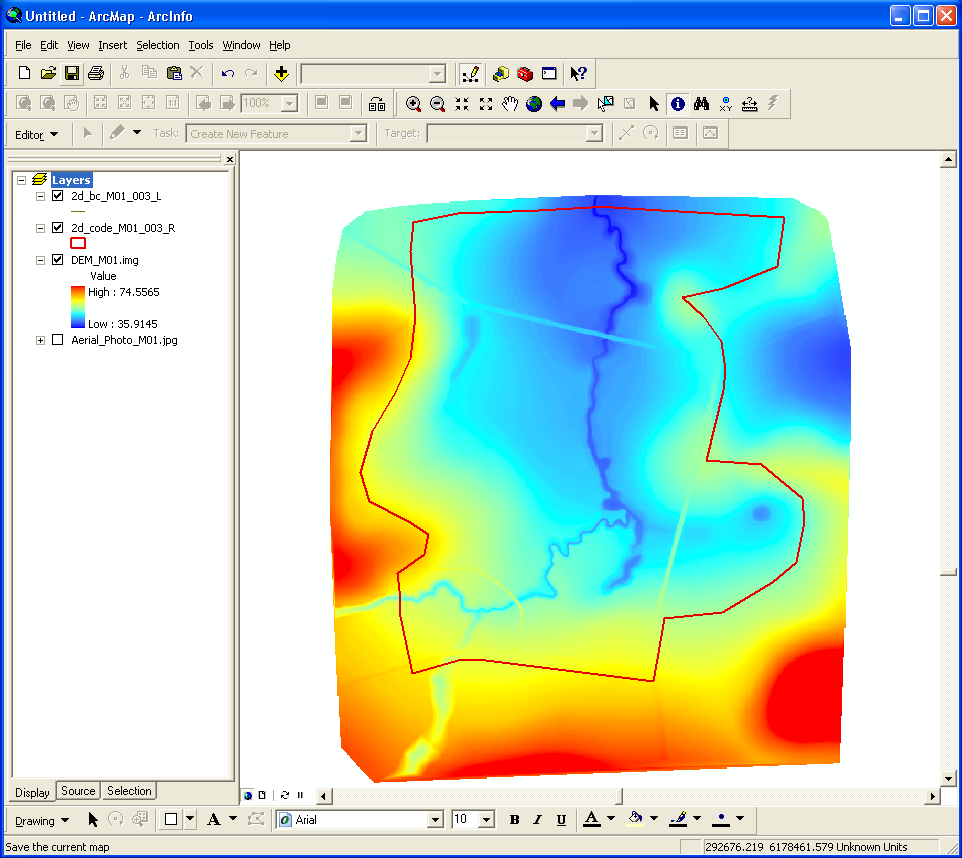
We will first digitise the inflow boundary at the lower left of the map window above. To do this:
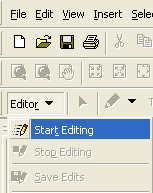
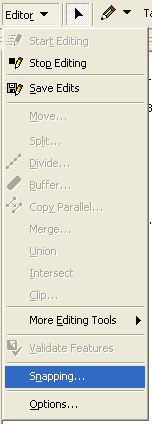


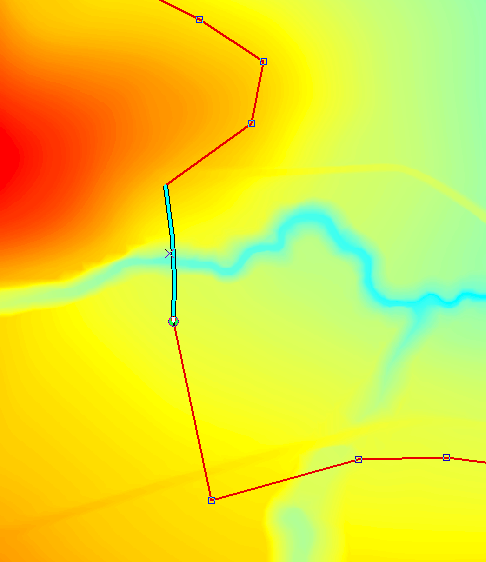
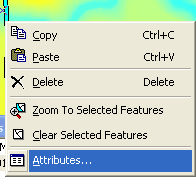
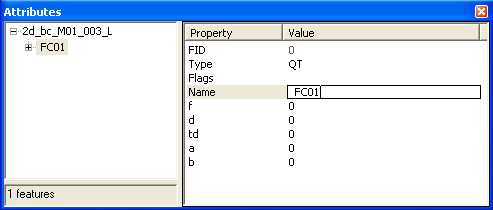
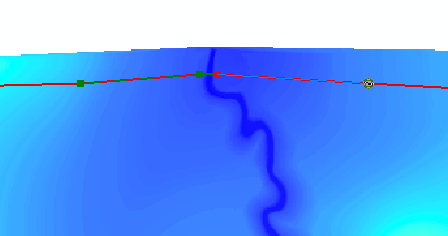
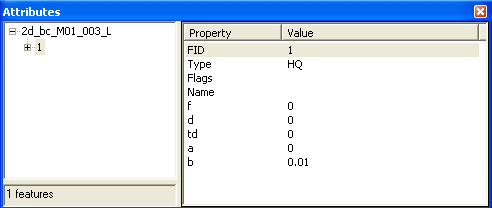
2d_sa Type Boundary
The next step is to create an internal inflow boundary using a source-area inflow this is done with a 2d_sa type layer.
- Open the 2d_sa_empty_R.shp template file from the TUFLOW\model\gis\empty\ folder, by either dragging it using Windows explorer or using Layers >> Add Data.
- Save a copy of the shapefile as 2d_sa_M01_002_R.shp in the TUFLOW\model\gis\ folder. To do this right click on file in the table of contents, and select Data >> Export Data. When prompted select Yes to add the exported data to the map as a layer.
- Remove the 2d_sa_empty_R (right click and select remove). We will digitise the inflow boundary that covers the dam location shown below:
- To digitise the inflow region object select Editor >> Start Editing. Ensure that the "Create New Feature" and Target (2d_sa_m01_002_R) are correct and then select the sketch tool.
Digitise a polygon around the dam. - When finished drawing the polygon, right click and select "Finish Sketch", alternatively hit the "F2" on the key.
- Use the "Edit Tool", select the newly created region object, right click and select 'Attributes".
Enter "FC04" (FC zero four, without the quotes) into the name attribute field. Note that as the object is in the 2d_sa (2d source-area type GIS layer) we do not need to specify a boundary type. - To finish editing the layer, select Editor >> Stop Editing and when prompted save the changes.
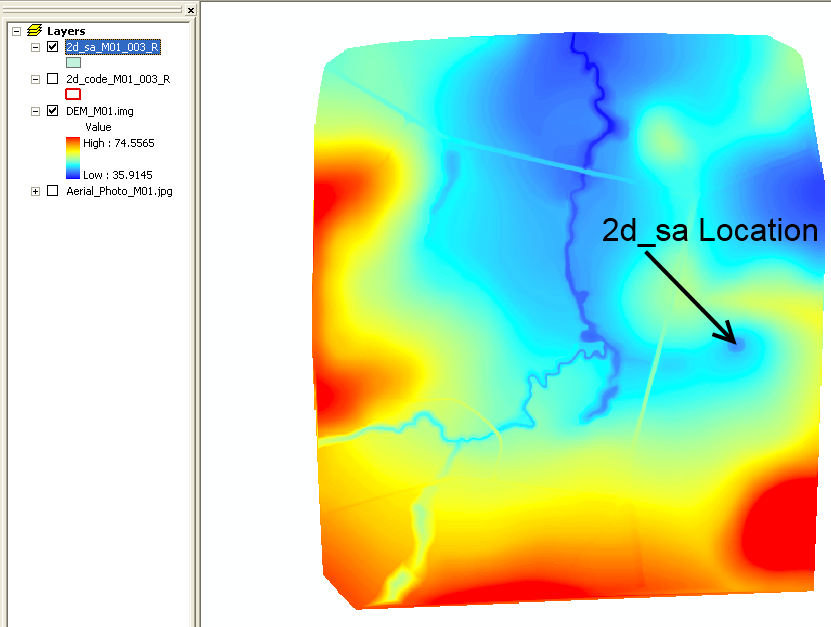
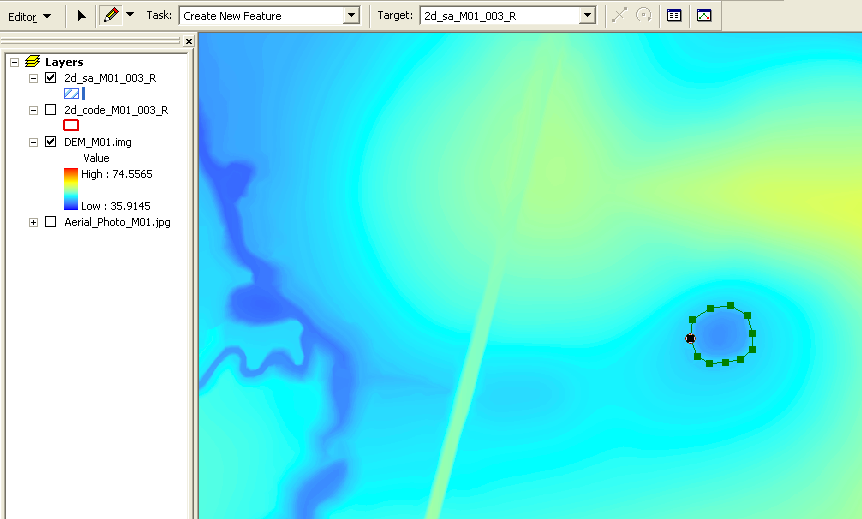
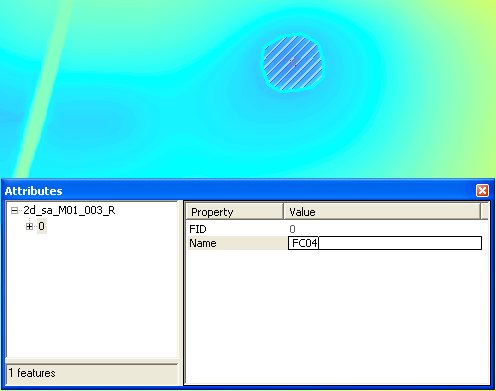
Conclusion
ArcMap has been used to create the 2d_bc layer that contains an upstream "QT" type inflow boundary and a downstream "HQ" stage-discharge type boundary. A second ArcMap layer (2d_sa) defines an internal source boundary. Our next step is to assign hydrographs to the boundary locations created in this page. Please return to the tutorial model page here.